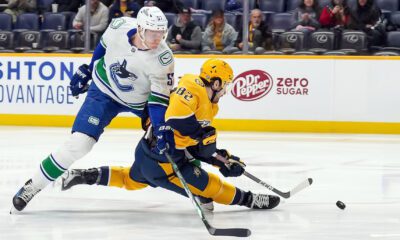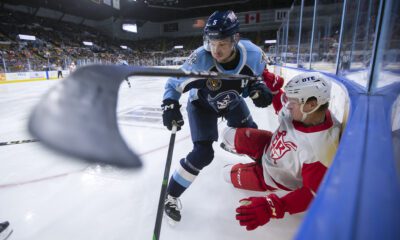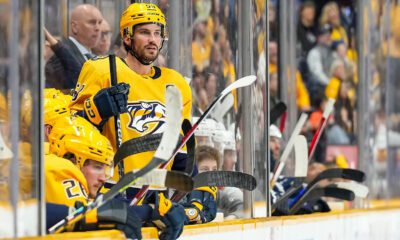Nashville Predators
Three Crucial Questions The Predators Still Need To Answer

The Nashville Predators are 44 games into their new era led by general manager Barry Trotz, head coach Andrew Brunette, and a new “Predators’ way.”
So, what exactly do we know about this team?
Well, the Predators have 49 points and hold the first wild card spot in the Western Conference. They’re just six points behind the Dallas Stars for third place in the Central Division with a few games in hand on the teams that are closely approaching, and they’ve maintained a +1 goal differential and a 99.7 PDO (100 is average), which measures a team’s shooting percentage plus save percentage.
In short, at least from a statistical standpoint, Nashville is average across the board with a handful of players really carrying the load.
Stylistically, the Predators play a more up-tempo system that’s less “structured” and more aggressively paced. Possession is a key component, and moving the puck to open spaces is paramount for success with the way Brunette wants to play.
Defenseman are not only asked to be aggressive in the offensive zone, the system demands it. A strong focus on offense and creativity can sometimes cause consternation for the defense, which has been evident over the course of this season.
Several times this season it’s looked as if players have checked out during varying periods of games. The 6-1 home loss to the Edmonton Oilers on Oct. 17, the 6-1 home loss to the Minnesota Wild in John Hynes‘ return on Nov. 30, plus more recent home losses to the Calgary Flames (Jan. 4) and the Anaheim Ducks (Jan. 9) are great examples.
Still, even with the fan grievances with certain players (Luke Schenn, Dante Fabbro, Cody Glass), Tyson Barrie’s trade request, and the inconsistency of the wins and losses, this Predators team is entertaining to watch.
As we pass the midway point of the 2023-24 season, here are the Predators’ second-half questions of most importance:
1. What happens with the goaltending?
Nashville’s elephant in the room is obviously the inconsistency of goaltender Juuse Saros. He’s had several poor performances this season, but he’s also stolen his share of games as well.
Through 34 starts, Saros has 17 wins, two shutouts, a 3.02 goals-against average and a .900 save percentage. He’s also been pulled five times.
Kevin Lankinen, on the other hand, has played in 13 games (nine starts, four in relief) with six wins and a 3.12 goals-against average and .898 save percentage. Eight of his 13 games have come against teams ranked in the top 10 in goals scored per game.
Neither Saros nor Lankinen have earth-shattering numbers, which is why I don’t think they matter for the Predators’ purposes here. What really matters is expected goals against, which determines how likely an unblocked shot attempt will turn into a goal scored. Under this metric, Saros is -8.7 and Lankinen is -2.1, according to Money Puck.
The issue with Saros appears to be his stamina. Simply put: he looks tired. Exhaustion typically leads to performance issues. Lankinen hasn’t had any endurance issues, but he’s not in net enough to establish any kind of rhythm.
The best path forward for the Predators to help both goalies out is to establish a 1A/1B starting split between Saros and Lankinen — at least through the next month or so — one that would give Saros more rest and Lankinen more playing time leading up to the March 8 trade deadline.
Both goaltenders would be hot commodities on the trade block, and Lankinen would be a great asset to make available for a contending team. He’s an unrestricted free agent this summer, so the risk and salary cap impact for any interested team would be minimal with his $2 million cap hit (pro-rated to $979,167 if traded after Jan. 15 with no salary retention). Remember, Nashville can only retain one more salary this season.
Should they trade Lankinen, the Predators could get an additional month or two of testing out a 1A/1B goalie scenario Saros and top prospect Yaroslav Askarov that would give them a good idea of what to expect going into next season. Both Saros’ and Askarov’s contract end after the 2024-25 season, affording Trotz a full season of evaluating both and seeing which he should move forward with in 2025.
The 1A/1B approach is something I strongly believe the NHL is moving towards, especially with the faster style of play and demand that the sport has on players, especially a goaltender’s, body each night.
2. What does Cody Glass’ future look like?
Glass has to be the most polarizing player on the Predators roster this season. He signed a two-year, $5 million contract over the offseason with the ideal goal of slotting in behind Ryan O’Reilly as the team’s No. 2 center.
Glass was challenged by Tommy Novak early on for that second center position, and Glass’ injuries, and perhaps a lack of confidence due to those injuries, has taken him out of the lineup more than he’s been in it this season (he’s played just 17 games, tallying a disappointing one goal and two points).
Similarly, but not as urgent, questions remain for Novak following his injury earlier this season. It’s clear that Glass is struggling with his confidence. Hockey has looked more like a chore for him than a passion, and he may be experiencing some degree of burnout. Nonetheless, competition remains for the second center spot with numerous players fighting it out.
Glass never had a team openly support him prior to coming to Nashville. The Vegas Golden Knights were in win-now mode and gave up Glass for next to nothing (25 games of Nolan Patrick, to be exact).
"In my personal journey, I found the way is to enjoy the game. I found little parts of the game that made it fun and then I was able to find my confidence. And I'm encouraging [Cody] to do that."#Preds HC Andrew Brunette talks Cody Glass rejoining the lineup this evening and… pic.twitter.com/G33v00C2CD
— Zach Gilchriest (@ZachGilchriest) January 9, 2024
The question now is do the Predators risk losing Glass by putting him on waivers to get him to the AHL where he can receive top minutes playing on a regular basis and open an NHL roster spot for someone else or do they keep him on the active roster and hope he rises to the occasion?
My take: My initial inclination would be to waive Glass and take the risk of losing him. It’s tough to pay a guy $2.5 million to play in the AHL and it wouldn’t benefit anyone here. You also aren’t trading a struggling player when their value is likely at its lowest. The potential is there, and he’s only 24, after all. Glass has similar size and skating style to Filip Forsberg, but he isn’t as strong on the puck and doesn’t use his size nearly as well. Could you imagine if he figured it out? Glass doesn’t need tough love, he needs more support and coaching — something it seems like he hasn’t had much of throughout his NHL career.
Trotz and Brunette appear to have not wavered from their belief in him, but their patience likely won’t last forever. At this time, Nashville is not an elite team, so it has time to figure it out. There are multiple players in Milwaukee that are champing at the bit to get to the NHL, that’s where the urgency of making a decision arises.
3. How does the pipeline in Milwaukee factor into things?
Nashville Hockey Now‘s Michael Gallagher detailed Trotz’s discussion with 102.5 The Game last week about the possibility of calling up some of the Predators prospects playing in Milwaukee.
There are currently five, young Admirals players who have shown great promise and could be close to making an impact in the NHL. Defensemen Spenser Stastney and Marc Del Gaizo are already acquainted with the NHL, having made respective appearances earlier this season. They are both NHL ready.
Fedor Svechkov, Egor Afanasyev, and Joakim Kemell round out the remaining three. All are waiver exempt, so if need be, Trotz can test them out in spot duty and send them back as often as he would like.
Since the beginning of December, the #Preds are averaging 1/2 a goal less per game than they did in November
— Michael Gallagher (@MGsports_) January 14, 2024
So what’s the fix for their stale offense? Barry Trotz believes the answer may just be in Milwaukee ⬇️https://t.co/CA982EMPK2
The one that would require further thought would be Kemell because of his age. He’s the only player of the five that is eligible for an entry-level contract slide because he signed at 18, meaning if he plays less than 10 NHL games this season, the Predators could extend his ELC by one year.
While not terribly concerning, the longer Nashville can keep a projected future core player on an entry-level deal in the salary cap era, the better. Again, the Predators are not currently an elite team, so they have time to let players marinate a bit longer than usual without sacrificing anything, but seeing how a top prospect performs on an NHL stage is always a bonus. The current core of Milwaukee players will really test Trotz’s resolve to his traditional idea of letting players stay in the AHL longer than many fans may like.
Stastney, Del Gaizo, and Afanasyev will all be restricted free agents this summer. Nashville holds their rights, and there’s no doubt the team will bring all three back. The question that remains is will any of those players compete for one of the spots held by a player currently on the team’s roster?
The Milwaukee five deserve a chance to prove themselves. How to best manage the current roster with the desire to develop and integrate younger talent will say a lot about the trajectory the organization believes it’s on.
Follow Clay Brewer on Twitter/X: @ClayBrewer10
Be sure to follow Nashville Hockey Now on X/Twitter, Facebook, YouTube and Instagram.


















